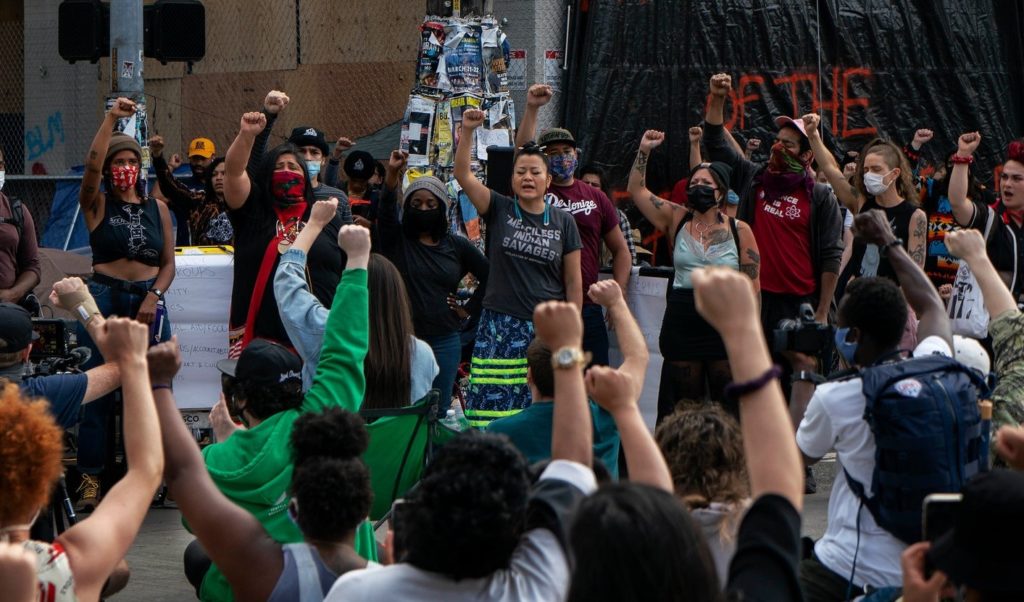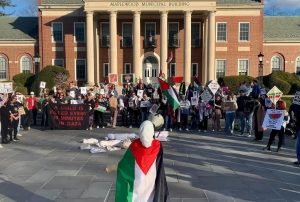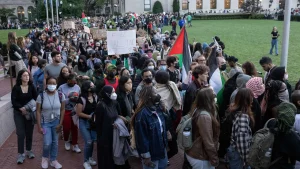At no point since the creation of formal police departments in the United States has the idea of their elimination been so pronounced and so popular. While the police have always been deeply hated by the communities they oppress most (particularly the very poor and people of color), they have nonetheless had historically high bipartisan approval ratings nationwide. This support seems to be fading, however. Indeed, the murder of George Floyd and the harsh repression of the uprisings that followed have forced many to question the integrity and even the very existence of the police. According to a Wall Street Journal/NBC News poll conducted between May 29 and June 2, during the height of the uprisings, 59% of Americans polled said they were more troubled by the murder of George Floyd and the actions of the police than by the actions of the protesters. Meanwhile, a Monmouth University poll conducted during that same period showed 78% approval for the protests.
This shift in attitudes — from supporting the police to actively questioning their very existence — is in large part the product of a militant vanguard of multi-racial youth and workers who took to the streets immediately following the killing of George Floyd and have since continued to march and protest. The many attempts by local and state governments to quell the initial uprisings — first by force and then with the promise of minor short-term reforms — have largely failed. Across the world, millions have taken to the streets in solidarity and against their own police forces. Meanwhile, in the United States, daily protests are ongoing in several cities, dozens of racist statues have been torn down, and protesters have established general assemblies or street occupations in at least two cities, with potentially more on the way. These protesters have gained legitimacy and support from wide sectors of the U.S. working class, not only because people are angry about police violence, but because they are fed up with the entire system. The government’s cruel and incompetent response to the coronavirus pandemic, which has now led to more than 100,000 preventable deaths, and the resulting economic crisis has revealed just how deeply flawed and unsustainable capitalism is. It is only natural that the built up anger and frustration with the capitalist state, and the crises it has given birth to, would eventually lead to a direct conflict with one of the very institutions that daily defends and enforces that system of oppression.
As Leon Trotsky pointed out in 1939, even before the mass militarization of local police departments:
Every state is a coercive organization of the ruling class. The social regime remains stable so long as the ruling class is capable, by means of the state, of imposing its will on the exploited classes. The police and the army are the most important instruments of the state. The capitalists refrain (though not fully, by far) from maintaining their own private armies declining in favor of the state, so as thus to hinder the working class from ever creating its own armed force.
In other words, the widely-accepted but entirely fallacious belief that the police are public servants and neutral arbiters of peace and order distorts the reality of class struggle, but it also distorts the fact that the working class needs an armed force of our own if we are ever to be free from the oppression of the police.
Now that the movement has put the very existence of the police on the table, it is necessary to begin to think about what kind of strategy and what types of organizations will be needed to really accomplish such a goal and how best to prevent the current regime from co-opting the demands of the movement.
The Yoke of Reformism
Since the uprisings began in late May, cities and states across the country have taken two contradictory approaches to quell the unrest. On the one hand, states and municipalities have sought to crush the protests through the use of violence and repression designed to scare protesters into submission. Tear gas, rubber bullets, brutal beatings, and scores of riot police were unleashed on protesters in hundreds of cities. Within just the first week, more than 10,000 protesters were arrested, and many are being held still on trumped up charges. At the same time, mayors and some governors have attempted to end the protests with promises of reform. Shortly after the initial uprisings in Minneapolis, for instance, the Minneapolis City Council voted on a path to eventually disband the police, while other cities, such as Los Angeles, moved quickly to pass legislation to decrease police budgets. But these reforms at this point are really just promises and are unlikely to lead to any substantive change in the way that the police behave. The ruling class has no real interest in ending police repression, especially against Black Americans, precisely because such repression is one of the pillars upon which their very power rests. Sure, the Bourgeoisie would prefer a less ruthless, violent, and controversial police force if that were possible, and they may be amenable to some changes in that direction, but regardless of what this or that bourgeois representative says, the fundamental nature of the police will not change until they are abolished, and abolishing the police is not something that can be achieved with legislation.
While the initial attempts to further repress protest led only to larger and angrier crowds, the effort to co-opt the movement with reforms, led largely by the Democratic Party, has been somewhat more successful, at least in quelling the initial uprisings. Indeed, though the protests continue to grow and adapt in all sorts of new ways, liberal and reformist co-optation remains a very real threat to the future militancy of the movement. Although reductions to police budgets, more social spending, and more community oversight are positive developments that can take away some of the sting of police violence and repression, they are vastly insufficient responses to the deeply ingrained centuries-long system of racist state repression. This is why socialists have to remember that, although we support any changes that benefit the working class and increase its power, ultimately our strategy is not one of reform, but of overthrow. So, the question becomes: how can socialists and activists avoid such co-optation while continuing to push the movement toward more radical conclusions and more radical forms of organization capable of really challenging the capitalist state?
As it stands, the movement runs the risk of being co-opted by two distinctly different expressions of reformism.
For mainstream Democrats, the movement has been embraced as a new opportunity to win votes, embarrass Trump, and whitewash their own racist history. There is perhaps no better example of this than the embarrassing photographs of white Democratic Party legislative leaders — including Nancy Pelosi and Charles Schumer — earnestly kneeling in Kente cloth in the halls of Congress where, along with the Republicans, their party has overseen the oppression of Black America for centuries. While national and local Democratic leaders have proposed some mild legislative reforms to reign in out of control police, such paliatives only distract from the fact that the murder of George Floyd took place under the watch of a Democratic mayor and governor. Likewise, the city and state where Breonna Taylor was murdered by police in her own home are also run by Democrats. Indeed, the Democrats have a long and terrible history of supporting police violence. After all, it was Democratic President Bill Clinton’s 1994 crime bill that launched the explosion of the U.S. prison population, increased the number of patrol officers on the streets, and led to the exorbitant police budgets that we see across the country today. Meanwhile the Democrats’ own presidential nominee has bizarrely argued that police should shoot people “in the leg instead of the heart.”
Meanwhile, the leadership of the Democratic Socialists of America (DSA), which has used the Democratic Party as a platform for its candidates for decades, has unfortunately largely turned its back on the idea of developing the movement into an open struggle against the exploitative and racist two-party system. While it is true that many rank and file members of the DSA have been in the street organizing protests, the Jacobin wing of the organization continues to pursue a strategy of socialism through electoral conquest. As such, the DSA has spent the vast majority of its resources promoting Democratic Party ballot line candidates across the country rather than use the energy of its 70,000 members to develop the struggle and promote independent socialist candidates to break with the Democrats.
Although the Democratic primaries of June 23 showed that a significant part of the electorate is willing to vote for Black, Brown, progressive, and even socialist candidates such as Jibari Brisport, the problem is that the electoral policy of the DSA is based on the support of Democratic candidates, and all of the energy that could have been put into the streets has in effect been put into the service of rebuilding one of the pillars of the regime. For instance, just two weeks ago, in the midst of the uprisings, the NYC DSA Steering Committee was telling members that the best way to keep the movement going was to go out and vote in the Democratic primaries. Such simplistic electoralism will not help keep the movement going. On the contrary, because it feeds into the same logic that the Democrats are using to co-opt the movement, it is a recipe for demobilization.
The role of socialists should instead be to promote the radicalization of the movement, and to encourage and develop every tendency towards self-organization, working class methods, and class independence that arises. However, it would be a mistake to intervene in the movement without proposing that a new political organization should emerge from it. We cannot fight on the streets while the Democrats do all the politics. We, the workers and young students who are the heart of the movement, have to build our own political organization, breaking with the capitalist parties, in order to intervene with a revolutionary perspective and to promote truly socialist and independent candidates who denounce both parties and put their candidatures at the service of the struggle.
Despite the political pressure to focus on short term reforms and electoralism, there are signs that the movement can and wants to go beyond such narrow tactics. In Detroit, for instance, protesters have been holding regular public assemblies to discuss strategy and earlier this month held a public tribunal of the Mayor and Chief of Police. In Seattle, protesters briefly occupied City Hall and have permanently taken over a six block section of the city known as the Capitol HIll Occupied Protest (CHOP). Meanwhile, just this week, thousands of protesters have converged in an occupation of the park adjacent to New York City Hall and have begun to openly and collectively discuss and debate their demands, which include, among other things, a $1 billion reduction of the NYPD budget. Such actions show that many in the movement are ready to do more than spontaneously heed the call to march by this or that activist group and are willing to build more militant forms of organization.
Workers’ Democracy and Self Defense
As promising as these developments are, they must be extended and deepened if we are to avoid the kind of co-optation, fatigue, or demoralization that so many other movements have experienced. And it is the role of all socialists to imagine the necessary steps for the movement to radicalize, spread, and embrace a revolutionary perspective. If we are going to take the demand to abolish the police seriously, then we need to be able to create the kinds of organizations necessary to kick the police out of our communities for good. One way to begin building such organizations is to create local assemblies all across the country in city centers, town squares, schools, and workplaces. The embryonic forms of such organizations are already taking shape in Seattle and NYC, but if we are to truly conquer “autonomous territories” for any length of time, it is necessary to forge an alliance across the entire working class in order to gain real control over transportation, distribution of goods and food, production and, of course, self-defense.
In order to forge a powerful alliance of workers and the oppressed, it is imperative that the movement embraces, in addition to the struggle for the eliminations of the police, a persistent confrontation with capitalism. The first task facing the labor movement is to kick out the police unions from their organizations. Forging a powerful alliance between workers and the oppressed requires the movement to take up a platform that includes confronting racism and the abolition of the police as well as a struggle for the most immediate demands of the working class that have been generated by the pandemic: the fight against unemployment and for health, education and housing. The struggle of the working class that exploded when the pandemic began is inextricably linked with the struggle against racism. Since capitalism is built on racism, and since it is people of color who have been hit hardest by the health crisis and the resulting crisis of unemployment, there is no defeating one without defeating the other. The combined health, economic, and social crises we are witnessing, and the mass uprisings in response to police terror, have once again put on the table the very question of the self organization of the working class and show the very real need for organizations of working class power and self defense.
Of course, when it comes to self-defense, the first example that comes to mind is the Black Panthers, who successfully developed armed militias to defend Black communities from police and racist violence. The Panthers were also able to win massive community support based mainly on the social programs they provided to address the most pressing needs of the Black masses in a country with endemic racial segregation. However, the limit of the self-defense promoted by the Black Panthers is that it was not based on mass democratic self-organization; they did not have the mass membership nor the methodology to organize in the workplaces beforehand, and they therefore did not have the fire power that comes from the workplace at the heart of capitalist production. The state was able to isolate the organization and violently repress the Panthers because they did not have the economic power or mass organization to fight the police offensively.
One example of successful worker self organization is the Alabama workers councils of the 1930s and 1940s, which are an important part of the history of Black struggle in the U.S. In spite of the increasingly right-wing orientation of the Communist Party of the United States (CPUSA) — driven by its Stalinist fraction that ended up in the disastrous popular-front politics with Roosevelt — it was communists who took on Alabama’s repressive, racist police state to fight for economic justice, racial equality, and civil and political rights for Blacks and whites. They did so by organizing Black laborers and sharecroppers, and a handful of whites, including unemployed industrial workers, housewives, youth, and renegade liberals, into democratically functioning councils. In 1930, the city of Birmingham, Alabama was one of the epicenters of the economic crisis and unemployment. The most affected were the Black workers who had to return en masse to a self-consumption agrarian economy in order to survive. The Black masses suffered from lack of housing, education, jobs, and social welfare. As Robin D.G. Kelley, author of Hammer and Hoe: Alabama Communists During the Great Depression says: “The demand for jobs was so great that numerous independent efforts were launched by industrialists and middle class organizations to relieve the situation.” But it wasn’t just economic demands. The Black working class in Alabama had to fight against the racist violence of the KKK and the police. At the initiative of the communist militants, neighborhood councils emerged throughout the city, many of them led by working women who quickly included sharecroppers, unemployed industrial workers, and women in charge of family relief. These councils, formed to fight the most adverse effects of the crisis, then took up the fight against the racism that plagued Black communities.
Also vital for the labor movement is the example of the councils of the unemployed that spread to several regions of the country in response to the mass unemployment created by the Great Depression. In many states, communists organized dozens of unemployment councils throughout the country through the Trade Union Unity League.
In 1929, when the Great Depression left millions of workers on the streets, communists and Trotskyists played a key role in organizing councils of the unemployed in several cities around the country. This was in the face of the refusal of the large emerging trade union centers to fight unemployment and organize the unorganized workers. These councils not only mobilized for unemployment insurance but also organized the working class to fight against all the effects of the crisis, for example, homelessness and evictions. As Christine Ellis tells of an unemployment council session in Chicago:
We spoke simply, explained the platform, the demands and activities of the unemployed council. And then we said, ‘Are there any questions?’…. Finally an elderly Black man stood up and said, ‘What you folks figure on doing about that colored family that was thrown out of their house today?… They’re still out there with their furniture on the sidewalk.’ So the man with me said, ‘Very simple. We’ll adjourn the meeting, go over there, and put the furniture back in the house. After that, anyone wishing to join the unemployed council and build an organization to fight evictions, return to this hall and we’ll talk about it some more.’ That’s what we did…everybody else pitched in, began to haul in every last bit of furniture, fix up the beds…and when that was all done, went back to the hall. The hall was jammed!
Seattle 1919
However, a less known and highly significant example of self-organization and self-defense in all its radical potential is that of the so-called “Washington Soviet” of 1919, which had its epicenter in none other than the city of Seattle. On February 6, 1919, at least 65,000 Seattle workers went out on a general strike. The workers also took control of the entire city for 6 days. The strike was in support of 35,000 shipyard workers, “then in conflict with the city’s shipyards owners and the federal government’s U.S. Shipping Board, which was still enforcing wartime wage agreements.” Seattle’s Central Labor Council, representing 110 unions affiliated with the American Federation of Labor (AFL), called the strike. According to historian Cal Winslow, the Seattle workers:
…created a culture of their own, with ‘clean’ unions not run by gangsters; with a mass newspaper owned by the workers, (the Seattle Union Record), which became the only newspaper of its kind in 1918, with socialist schools where classes were held both in their classrooms and outdoors; there were IWW choirs, community dances and picnics.
The Central Labor Council set up a General Strike Committee in which the rank and file delegates of all the unions participated, a genuine body of self-organization. While it lasted, the General Strike Committee took charge of running the whole city and essential services, without bosses, without the capitalist politicians, and without the police.
In his classic book A People’s History of the United States Howard Zinn describes how those six glorious days were lived while the working class made enormous revolutionary progress:
Then the city ceased to function, except for the services organized by the strikers to ensure essential needs. The firemen agreed to stay on the job. Laundry workers only cleaned hospital clothes. Vehicles authorized to drive carried signs reading ‘dispensed by the General Strike Committee.’ They set up thirty-five neighbourhood dairies. They organized a Workers’ War Veterans’ Guard to keep the peace. On the blackboard of one of their headquarters it read: The purpose of this organization is to preserve law and order without the use of force. No volunteer shall have power or be allowed to carry any kind of weapon. He will be allowed to use only persuasion. During the strike, the number of crimes in the city decreased.
In other words, for six days, the working class of Seattle kept territorial control in their hands by striking, reorganizing the city, and creating a veteran workers militia. They organized themselves as an alternative to bourgeois power, dropping the police and keeping the army at bay. Imagine this experience now, uniting Black and Latino neighborhoods with the workers who control production, distribution and services. Imagine this power now relying on workers’ militias to confront repression and defend against attacks by white vigilantes. But we need firepower, and that firepower is in the hands of the working class and the oppressed. This is the only way to turn these uprisings into a struggle against the entire system of racist oprression and capitalist exploitation.
Dual Power
In his definitive The History of the Russian Revolution, Leon Trotsky explains the importance and necessity of dual power for any successful revolution. “No historic class,” Trotsky says:
…lifts itself from a subject position to a position of rulership suddenly in one night, even though a night of revolution. It must already on the eve of the revolution have assumed a very independent attitude towards the official ruling class; moreover, it must have focused upon itself the hopes of intermediate classes and layers, dissatisfied with the existing state of affairs, but not capable of playing an independent role.
As Trotsky makes clear here, the seeds of revolution are almost always developed in self-organization and are often planted years or — as in the case of the Bolshevik Revolution — even decades in advance. The Russian soviets are only one example of how such organizations of dual power may develop.
The current uprisings against police violence, though far from anything resembling a revolutionary or even pre-revolutionary moment, nonetheless have the potential to pose the question of power, particularly the question of police power, which is central to the existence of the state. While the voices demanding abolition remain a minority compared to those who still misguidedly believe the police can be reformed, and though they face a fierce campaign of repression and co-optation from all sides of the political spectrum, the demand itself is qualitatively different than anything we have seen in the U.S. since at least the 1960s.
Whether or not new forms of self-organization and self-defense will arise from these protests depends upon the class consciousness of those currently engaged in struggle, the ability of the left to intervene with a revolutionary program, and their willingness and ability to link the struggle against police oppression with the broader struggles that are already arising because of the economic and social crisis generated by the pandemic. From a revolutionary perspective, such forms of self-organization, were they to take shape, and were they further made necessary by the conditions of the ongoing crisis (including the entrance of organized white vigilantism), could become the nascent forms of an eventual system of dual power capable of seriously challenging the state and winning significant demands. The reformists will say that this is impossible, that we should be content with street demonstrations and cosmetic reforms. For us, beyond whether the current movement develops in a revolutionary way or not, it is fundamental that a sector of the broad mobilized people draws the conclusion that it is necessary and urgent to challenge the system and that it is a struggle worth fighting. May the word revolution once again blossom in the mouths of this new generation.
While such prognoses may sound overly optimistic considering where the U.S. was politically just a year or two ago — when the left was dominated by the reformist campaign of Bernie Sanders — it’s clear that something has changed. We are witnessing the political awakening of a whole new generation of activists and protesters who are far more interested in confronting capitalism and the state and have much less to lose than almost any U.S. generation before them. Add to this a global pandemic, mass unemployment (which has hit young people especially hard), and an economic crisis likely to rival the Great Depression, and it’s easy to see that the future of the coming period of struggle in the U.S. is still wide open. Building and experimenting with new forms of self-organization and self defense, linked up with working class struggle and represented by a revolutionary party for the working class, is perhaps the most important task for the movement right now.












